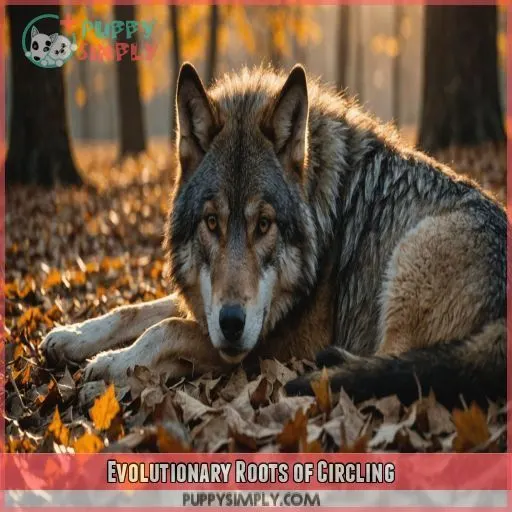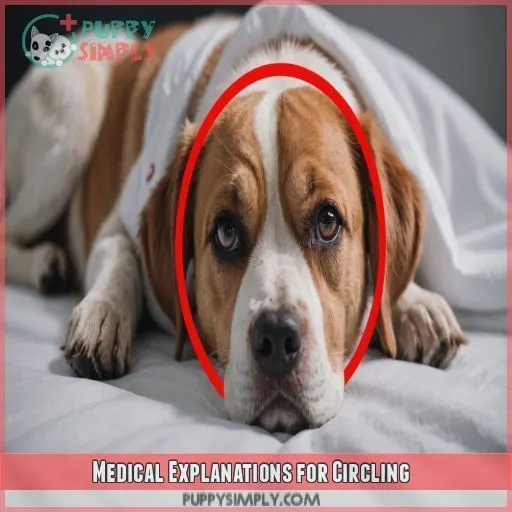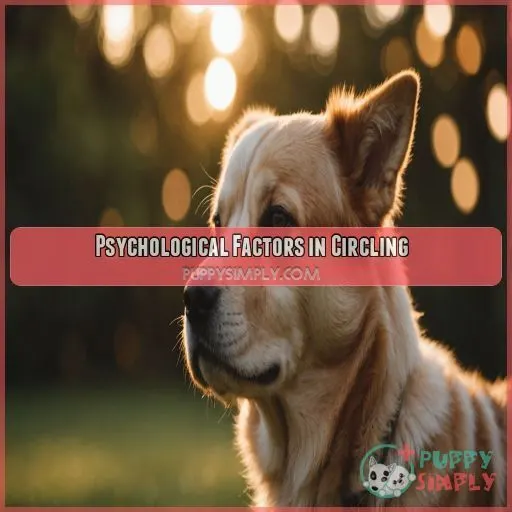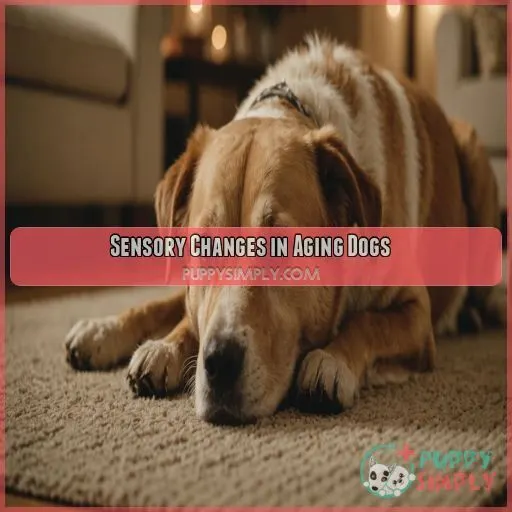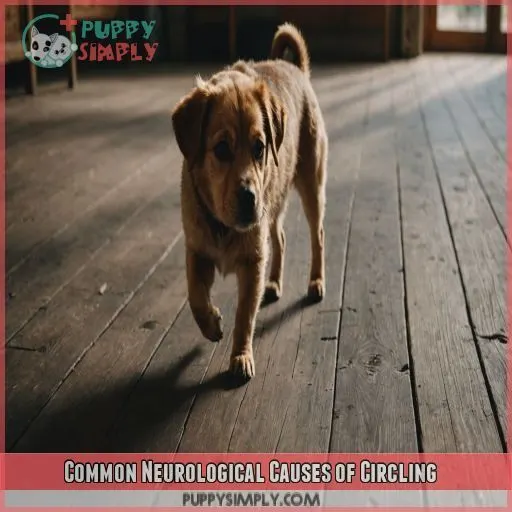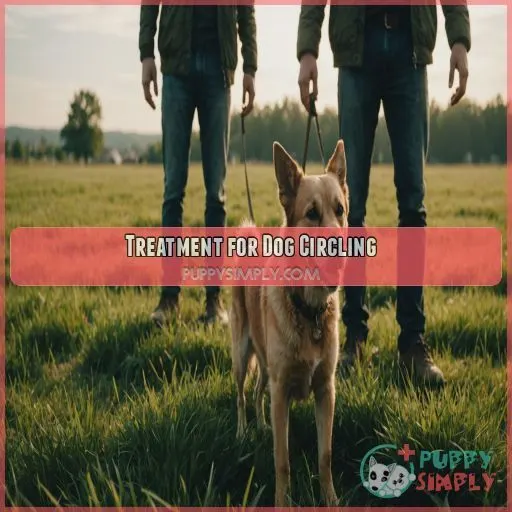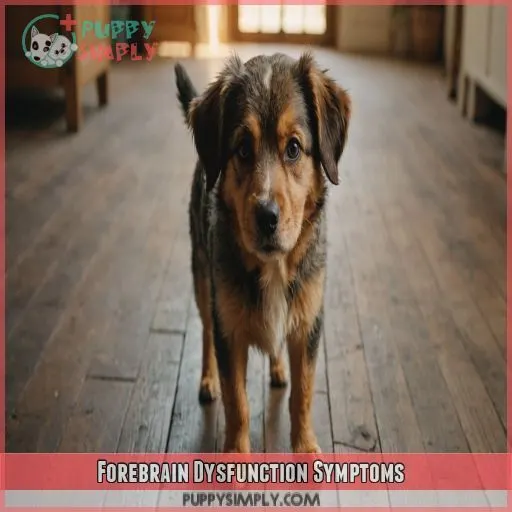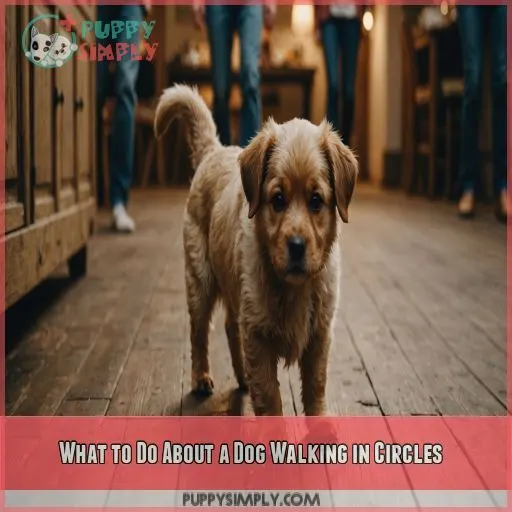This site is supported by our readers. We may earn a commission, at no cost to you, if you purchase through links.
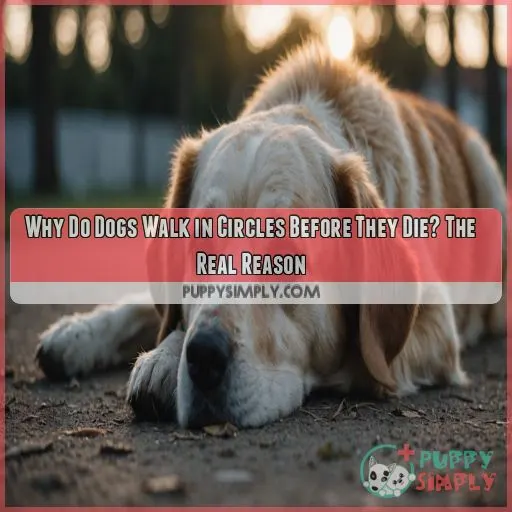 Your dog’s circling might be down to a bunch of reasons. It could be an instinct inherited from their wild ancestors, or it might be their way of dealing with the stress and confusion of aging. Maybe they’re looking for a safe, quiet spot to rest, or they could be in pain or discomfort. Circling could also be a sign of neurological issues.
Your dog’s circling might be down to a bunch of reasons. It could be an instinct inherited from their wild ancestors, or it might be their way of dealing with the stress and confusion of aging. Maybe they’re looking for a safe, quiet spot to rest, or they could be in pain or discomfort. Circling could also be a sign of neurological issues.
There are a lot of reasons why dogs do this, and if you want to learn more, keep reading.
Table Of Contents
- Key Takeaways
- Evolutionary Roots of Circling
- Medical Explanations for Circling
- Psychological Factors in Circling
- Sensory Changes in Aging Dogs
- Observations From Pet Owners
- Common Neurological Causes of Circling
- Treatment for Dog Circling
- Forebrain Dysfunction Symptoms
- Dealing With End-of-Life Care for Dogs
- What to Do About a Dog Walking in Circles
- Frequently Asked Questions (FAQs)
- What does it mean when an older dog walks in circles?
- How do dogs act when they are near death?
- What are the final moments of dogs death?
- How do old dogs act before they die?
- What are the signs my dog is dying?
- How can I help my dog with joint pain?
- Why does my dog circle me when I call them?
- Can I stop my dog from circling?
- How do I know if my dog is confused?
- Conclusion
Key Takeaways
- Circling can be a comfort-seeking behavior for dogs, a way to find a secure resting spot, just like their wild ancestors.
- It could be a sign of something more serious, like neurological issues, pain, or underlying health problems. Keep an eye out for other symptoms and behavior changes, and don’t hesitate to call the vet.
- Aging dogs may circle due to anxiety, confusion, or sensory changes. Their world might be a bit wobbly, and circling is their way of coping and finding familiarity.
- Don’t ignore the signs. If your furry friend starts spinning, it’s time to visit the vet. They’ll help you figure out the cause and provide comfort to your four-legged family member.
Evolutionary Roots of Circling
The circling behavior you see in dogs today has its roots in their wild ancestors, who prepared safe resting spots in this way. Even though your pup doesn’t need to find a secure den, this instinctual behavior persists, driven by their genetic makeup and the need for security and comfort.
Remnants of Wild Ancestors
You may have noticed your furry friend walking in circles before settling down for a nap, and you might wonder if this behavior has any significance. Well, it turns out that this circling habit might just be a remnant from their wild ancestors. Here’s a breakdown of this intriguing behavior:
- Wolf Pack Behavior: In the wild, wolves often circle before resting as a way to make sure the area is safe and comfortable. This behavior is thought to have been passed down to domestic dogs through generations of evolution.
- Den Construction: Wolves would construct dens for resting and raising their young. Circling behavior could be related to this instinctual need to prepare a safe space.
- Hunting Instincts: Wolves also circle before capturing prey, perhaps to disorient their target or assess the best angle of attack. This circling could be an inherited hunting instinct.
- Territorial Defense: Circling behavior may also be linked to marking and defending territories, a key aspect of wolf pack dynamics.
Instinctual Behavior in Domestic Dogs
Dogs have evolved from wild ancestors, and some of their behaviors are rooted in this past. Circling is an instinctual behavior that persists in domestic dogs, even though they don’t need to find a secure den anymore. This behavior is driven by the instinctual memory of creating a safe haven, which can offer comfort even when facing death.
Genetic Makeup and Circling
The circling behavior has its roots in a dog’s genetic makeup, a trait passed down from their wolf ancestors. It’s an evolutionary adaptation that’s stuck around, even as dogs became domesticated. Think of it as a hardwired instinct, a holdover from when finding a secure spot to rest was vital for survival.
Medical Explanations for Circling
Sometimes, it’s not about your furry friend’s evolutionary past, but their current health. Let’s take a closer look at the medical reasons why your dog might be walking in circles. Neurological conditions, pain, or underlying health issues could be the culprit.
Neurological Conditions and Circling
Walking in circles before death can be a sign of neurological conditions in dogs. Here are three things to know about this:
- Vestibular disease, brain tumors, strokes, and other neurological issues can affect a dog’s balance and coordination, leading to circling.
- Forebrain dysfunction, caused by strokes or other conditions, can result in circling, along with other symptoms like head pressing and seizures.
- Canine cognitive dysfunction (CCD) or doggy dementia can cause circling, especially at night, as part of the confusion and disorientation associated with these conditions.
Pain and Discomfort as Causes
Pain and discomfort are significant reasons why dogs walk in circles before they die.
Conditions like arthritis can make lying down painful, while heart conditions like congestive heart failure can lead to fluid buildup in the lungs, causing breathing difficulties when your pup is trying to rest.
If your furry friend is circling due to physical pain or discomfort, getting them to a vet right away is really important.
Don’t wait—get your pup the pain management they need to ease their suffering and improve their quality of life.
Underlying Health Issues and Circling
Circling behavior in dogs can be a sign of underlying health issues. It’s important to monitor your dog’s overall health and behavior closely. Regular vet checkups can help spot potential problems early on.
As dogs age, they may experience health conditions that impact their mobility and comfort, such as arthritis or joint problems. These ailments can cause pain and discomfort, leading to circling behavior as your dog tries to find a position that relieves the pain.
Psychological Factors in Circling
As dogs age, they may experience heightened anxiety or confusion, which can lead to circling as a way to cope with these emotions. This behavior could be their way of seeking reassurance and comfort from their owners, especially as they navigate the stresses of aging and the approaching end of life.
Anxiety and Confusion in Aging Dogs
As your dog ages, they may experience anxiety and confusion due to cognitive decline, or what’s often referred to as senior dog dementia. This can lead to circling behavior as a way to cope with their emotional turmoil. Here are some key points to keep in mind:
- Cognitive decline: Just like humans, dogs can experience a decline in mental faculties as they age, leading to confusion and disorientation. This can manifest as circling behavior, especially at night.
- Anxiety and stress: The approaching end of life can be a stressful and anxiety-inducing time for dogs, causing them to seek reassurance and comfort. Circling may be their way of trying to cope with these emotions.
- Behavioral changes: Keep an eye out for changes in your dog’s routine, appetite, and interactions. These can be indicators of their emotional state and overall well-being.
- Sensory changes: Vision and hearing loss, as well as a decline in their sense of smell, can contribute to confusion and disorientation.
- Comfort and reassurance: Providing a supportive and comforting environment becomes really important during this time. It can help alleviate some of the psychological stress your aging dog may be experiencing.
Coping Mechanisms and Circling
As your dog ages, they may start circling due to heightened anxiety or confusion. This circling behavior could be their way of coping with the stress of aging and the approaching end of their life. Think of it as their attempt to find a sense of comfort and familiarity in a time of uncertainty.
| Aging Dogs | Coping Mechanisms | |
|---|---|---|
| Psychological Factors | Heightened anxiety and confusion | Circling behavior |
| Solution | Provide a supportive environment | Monitor their emotional cues |
| Impact | Alleviate psychological stress | Identify underlying health issues |
Emotional Turmoil and Behavioral Changes
As your dog reaches their twilight years, you might notice them acting a little differently. They could become more anxious or confused, and this can lead to them walking in circles as a way to cope with their changing emotions. This period of their life can be stressful, and just like us, they might need some extra comfort and support.
Sensory Changes in Aging Dogs
As your dog gets older, they might start walking in circles due to sensory changes. Vision and hearing loss, as well as a decline in their sense of smell, can all contribute to this behaviour. Let’s explore how these changes impact their world and what you can do to help them navigate it.
Vision Decline and Circling
As dogs age, their vision may deteriorate, making it challenging for them to navigate their surroundings.
This can lead to circling behavior as they try to familiarize themselves with their environment.
If your furry friend is having trouble seeing, they might walk in circles to gather information about their surroundings and compensate for their declining eyesight.
It’s like they’re trying to create a mental map of the area to feel more confident and secure.
Hearing Loss and Auditory Cues
Hearing loss can also trigger circling behavior in aging dogs.
They may circle in response to familiar sounds or auditory cues as a way to adapt to their changing sense of hearing.
This can be disorienting, causing them to circle as they try to make sense of their surroundings.
It’s like when you mishear someone and have to ask, "Huh? What did you say?" only your dog’s doing it with their whole body.
Olfactory Sensitivity and Circling
As your dog gets older, their sense of smell might weaken. This can cause them to start circling as they try to pick up scents or figure out where they are. Imagine walking into a room and not being able to smell your favorite meal cooking—it’d be pretty confusing!
Observations From Pet Owners
You might’ve noticed your furry friend walking in circles, and it’s got you wondering if it’s something to worry about. Pet owners often observe this behavior, and it can be a source of concern.
Individual Variations in Circling
Pet owners have noticed variations in circling behavior among dogs. Some dogs circle extensively, while others rarely do it at all. This behavior is often linked to a dog’s underlying health and emotional state. Changes in their daily routine, appetite, and interactions can indicate they sense something is different, physically or emotionally.
Comfort-Seeking Behavior and Circling
It’s totally normal for pet owners to notice their furry friends walking in circles before they pass away, and it’s often linked to a natural instinct for comfort and security.
Some dogs might circle near their owners, looking for that extra closeness and reassurance. It’s like they’re saying, "Hey, I know I’ve always been your loyal companion, but right now, I need you just as much." This circling behavior is their way of seeking a safe haven, even if it’s just one last time.
Changes in Daily Routine and Appetite
Pet owners often notice shifts in their dog’s daily habits and eating patterns as they get older or deal with health problems. These clues can help you understand their emotional and physical state:
- Appetite: Notice if your dog is eating less or more. This could be a sign of health issues or emotional stress.
- Sleep: Keep an eye on changes in sleep patterns. Sleeping more or less could mean discomfort or changing energy levels.
- Water: Increased water intake might signal a health issue. Decreased intake could lead to dehydration.
- Socialization: Pay attention to your dog’s need for attention and interaction. They might be seeking comfort or needing more rest.
Common Neurological Causes of Circling
If your furry friend starts walking in circles, it could be more than just a quirky habit. Sudden circling can be a red flag for potential neurological issues. Let’s take a closer look at some common neurological causes of this behavior and explore what might be going on in your pup’s brain.
Brain Tumors and Forebrain Dysfunction
brain tumors are a serious health concern for dogs, and they can lead to forebrain dysfunction, a common cause of circling behavior. These tumors are characterized by abnormal cell growth that damages healthy brain tissue and disrupts normal function. When a brain tumor affects the forebrain, it can result in a range of symptoms, including circling, seizures, behavior changes, and even blindness.
If you notice your dog exhibiting circling behavior, it’s important to see a vet right away. Brain tumors can progress quickly and affect your dog’s quality of life. Early diagnosis and treatment are essential for managing this condition and improving your dog’s prognosis. Stay vigilant, and don’t ignore the signs.
Strokes and Brain Inflammation
Another common neurological cause of circling is strokes.
These occur when blood vessels are blocked or burst, cutting off oxygen to nerve cells and causing damage.
Depending on the affected area of the brain, a dog might only circle to one side.
Brain inflammation, or encephalitis, is another potential cause.
This is when the brain or its surrounding membranes become inflamed, disrupting their normal function.
Encephalitis can be triggered by infections, autoimmune issues, or exposure to toxins.
Hydrocephalus and Brain Swelling
Hydrocephalus, a condition caused by cerebrospinal fluid buildup in the brain, can lead to brain swelling and increased pressure. This, in turn, affects your dog’s brain function, making it difficult for them to walk in a straight line. Here’s what you need to keep in mind:
- Toy breeds are more susceptible: Unfortunately, certain toy dog breeds have a higher risk of developing hydrocephalus, so it’s important to be aware of this predisposition and monitor your dog closely for any potential symptoms.
- Symptoms beyond circling: While circling is a noticeable symptom, hydrocephalus can also manifest as a domed skull, a soft spot on your dog’s head, wide-set eyes, slower growth, and a smaller stature.
- Don’t delay specialized veterinary care: If you spot any of these symptoms, immediate action is key. Get your dog to a specialized vet as soon as possible. Early diagnosis and treatment greatly improve your dog’s prognosis.
Treatment for Dog Circling
If your furry friend’s circling behavior has you worried, it’s time to take action. While it’s not always a cause for concern, circling could indicate underlying health issues that need addressing.
Let’s explore the treatment options and find out when it’s time to call the vet.
Addressing Underlying Conditions
Since circling is a symptom, not a disease, it’s important to figure out what’s causing it and address those issues. Here’s a table to help you recognize potential causes and their treatment options:
| Potential Cause | Treatment Options |
|---|---|
| Brain Tumors | Veterinary diagnosis and treatment |
| Strokes | Veterinary care, medication |
| Brain Inflammation | Veterinary attention, anti-inflammatories |
| Hydrocephalus | Specialized veterinary care |
Veterinary Neurologist Referral
If your furry friend is circling, don’t panic. A veterinary neurologist can help. They’re the experts in diagnosing and treating neurological conditions, so they’ll get to the root of the problem. Here’s what you need to know:
- Neurologist Expertise: These specialists focus on the brain and nervous system. They’re like the detectives of the veterinary world, skilled at uncovering the cause of your dog’s circling.
- Referral Process: Your regular vet will likely refer you to a neurologist if they suspect a neurological issue. It’s like going to a specialist for extra help—they have all the tools to figure out what’s going on.
- Diagnosis Tools: Neurologists use advanced imaging tests to see what’s happening in your dog’s brain. These tools are key for an accurate diagnosis, so you can get the right treatment.
- Treatment Options: Depending on the cause, treatment options may vary.
- Prognosis & Cost: It’s important to take action early. Treatment costs can differ, but your vet will be there to guide you through the process.
Treatment Options and Supportive Care
Treatment options vary depending on the cause of your pup’s circling. Surgery, medication, and supportive care may be recommended. Early intervention is key, so don’t delay seeking help.
Forebrain Dysfunction Symptoms
If your furry friend starts walking in circles, it could be a sign of forebrain dysfunction. This is a serious issue that requires immediate attention, and it’s important to know the symptoms so you can take swift action.
Circling and Forebrain Dysfunction
Your furry friend’s circling behavior might be more than meets the eye, especially if it’s paired with other symptoms. Let’s dig into the connection between circling and forebrain dysfunction.
Forebrain dysfunction is a common cause of circling behavior, and it’s characterized by an inability to walk in a straight line or change direction. This happens when there’s damage to the forebrain, which controls movement and behavior. Here are some key symptoms of forebrain dysfunction to watch out for:
- Blindness: Vision loss can occur due to the dysfunction.
- Head pressing: Your dog may compulsively press their head against surfaces.
- Behavior changes: Keep an eye out for sudden shifts in personality, like becoming withdrawn, irritable, or confused.
- Brain inflammation: This can disrupt normal brain function and is often linked to forebrain issues.
- Brain tumors: Abnormal cell growth can damage the forebrain and cause a range of symptoms.
Seizures and Abnormal Brain Activity
Seizures are another symptom of forebrain dysfunction. They can manifest as a loss of consciousness and convulsions due to abnormal brain activity. If your pup starts having seizures, it’s a clear sign that something’s up in their brain and you should rush them to the vet.
Behavior Changes and Head Pressing
When a dog starts circling, it can be a sign of something more serious going on in their brain. This behaviour is often linked to forebrain dysfunction, which can cause a range of other symptoms, including:
- Sudden personality shifts, like becoming more withdrawn, irritable, or confused
- Compulsive head pressing against surfaces
- Loss of vision
- Seizures or convulsions due to abnormal brain activity
Dealing With End-of-Life Care for Dogs
As your furry friend nears the end of their life, you might notice changes in their behavior, including walking in circles. This can be a difficult and emotional time, and it’s important to know how to provide the best care for your dog.
In this section, we’ll explore the steps to take when dealing with end-of-life care, offering practical guidance and emotional support during this challenging journey.
Terminal Agitation and Restlessness
As your dog reaches the end of their life, you might notice something called terminal agitation or terminal restlessness.
This can happen in the final stages of a serious illness or as they’re nearing the end.
It’s like a storm of restlessness, agitation, confusion, and vocalization.
Not all dogs go through this, but if they do, it’s important to know that veterinary care can help manage these symptoms and provide palliative care.
Providing Comfort and Care
Creating a safe and comforting environment for your furry friend during their final journey is paramount. By observing changes in their routine, appetite, and interactions, you can gain insights into their emotional state and provide the support they need as they navigate their golden years.
Palliative Care and Symptom Management
When your dog is nearing the end of their life, it’s important to focus on their comfort and well-being. Here’s a quick guide to help you through this tough time:
- Pain relief: Make pain management a top priority to help your furry friend feel comfortable.
- Symptom control: Work with your vet to address any underlying health issues and minimize any behaviors that cause distress.
- Quality of life: Create a safe and familiar environment, especially if your dog is experiencing sensory changes.
- Hospice care: Provide a supportive space, offering closeness and reassurance.
- Veterinary care: Stay in close contact with your vet to manage symptoms and provide palliative care.
- Prioritize pain relief for conditions like arthritis.
- ⚕️ Address health issues to reduce circling and other symptoms.
- Make their environment safe and familiar.
- ❤️ Offer closeness and a supportive space.
- Stay in touch with your vet for symptom management.
What to Do About a Dog Walking in Circles
If your dog starts walking in circles, it’s a red flag that something might be wrong. Don’t panic, but do take them to the vet as soon as possible to get them checked out and rule out any serious underlying health issues.
Immediate Veterinary Attention
If your furry friend starts walking in circles, don’t panic, but don’t ignore it either. It’s time to channel your inner detective and take some notes. Observe the following:
| Behavior | Possible Cause | Action |
|---|---|---|
| Frequency | How often is your dog walking in circles? | Note the frequency to help identify patterns. |
| Duration | How long does each circling episode last? | Time the duration to assess the severity. |
| Triggers | Does anything seem to trigger the circling? | Identify potential triggers to help determine the cause. |
| Other Symptoms | Are there any other unusual behaviors or physical changes? | Take note of any accompanying symptoms for a fuller picture. |
| Environment | Are there any changes in your dog’s environment? | Consider factors like new furniture, lighting, or sounds that might affect their behavior. |
After you’ve gathered this intel, it’s time to call in the pros. Contact your veterinarian and share your observations. They’ll be able to guide you on the next steps, which may include an in-person appointment for a proper diagnosis and treatment plan. Remember, you’re not alone in this—your vet is your partner in keeping your pup healthy and happy.
Identifying Underlying Causes
If your furry friend starts walking in circles, it’s important to figure out why. Here’s what to do:
- Seek veterinary advice: A vet can give your dog a checkup and run tests to see if there’s a health problem. Don’t hesitate to get help from a pro, it could make a big difference.
- Monitor behavioral changes: Keep a close eye on your dog’s daily routine, how much they eat, and how they act around others. Changes in these areas can give you clues about how they’re feeling physically and emotionally. For example, not eating much could mean they’re in pain or uncomfortable.
- Observe their environment: Pay attention to your dog’s surroundings and anything that might be bothering them. For instance, circling could be their way of dealing with changes to their senses, like losing their sight or hearing. Making sure they’ve a safe and familiar place can help reduce stress.
Addressing Pain and Discomfort
If your furry friend is experiencing pain and discomfort, it’s important to take action to help them feel better. Here are some practical steps to help your pup find relief:
| Pain Management Techniques | Comfort Measures |
|---|---|
| Consult your vet for pain medication or natural remedies like CBD oil | Provide a cozy bed with soft blankets and pillows |
| Try arthritis supplements or joint support treats | Keep their environment calm and quiet |
| Gentle massage or warm compresses can help soothe sore joints | Make sure they’ve easy access to food, water, and favorite toys |
| Assist with mobility using a harness or sling | Offer extra cuddles and reassurance |
Frequently Asked Questions (FAQs)
What does it mean when an older dog walks in circles?
It’s not a simple walk in the park when your old dog starts walking in circles. It could be a sign of anxiety, confusion, or even pain. It might be their way of seeking comfort, like a hug, or a trip to the vet if it’s something more serious.
How do dogs act when they are near death?
As your dog nears the end of their life, they might become restless, anxious, or confused. Their mental state may decline, and they could start pacing or circling. They might also vocalize more, showing signs of distress.
What are the final moments of dogs death?
You might see your dog pacing or wandering off to be alone. They could be disoriented, anxious, or in pain. Maybe they’re seeking a quiet spot to pass away. These are signs that the end is near.
How do old dogs act before they die?
Before their time comes, older dogs might get anxious or confused, and circling helps them cope. Their senses mightn’t be what they used to, so they circle to get their bearings. Keep an eye on their daily habits, appetite, and how they interact with others. These can clue you in on what they’re feeling.
What are the signs my dog is dying?
Your dog might be dying if they’ve a decreased appetite, weight loss, lethargy, difficulty breathing, pain, or loss of coordination and mobility. If you’re worried, seek veterinary attention.
How can I help my dog with joint pain?
Orthopedic dog beds and non-slip mats can ease joint pain and prevent injury. Try daily exercise, physical therapy, and weight management to reduce pain. Ask your vet about medication, joint supplements, and TENS therapy.
Why does my dog circle me when I call them?
Your dog might be circling you out of excitement, to show affection, or to herd you. However, it could also be a sign of anxiety or a medical condition.
Can I stop my dog from circling?
You can’t stop your dog from circling, but you can address the underlying causes. If circling is frequent and intense, it’s important to see your vet. This behavior could indicate pain, discomfort, or a serious medical issue.
How do I know if my dog is confused?
Your dog might be confused if they’re tilting their head, licking their lips, scanning their surroundings, or hyperactive. Senior dogs may also forget commands or show disinterest in play or attention.
Conclusion
Why do dogs walk in circles before they lie down? It could be as simple as them looking for a comfortable spot to rest.
It could also be a sign of a neurological issue.
The circling behavior might be linked to their wild ancestors.
It could also be a sign of stress and confusion.
If your furry friend starts spinning, it’s worth keeping an eye on them and consulting your vet.

